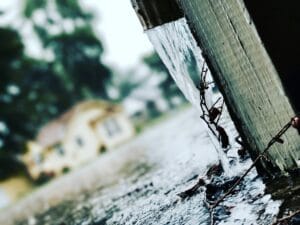Imagine a rainy night where every droplet races down your roof, finding a path to escape. But what if those droplets don’t have a clear route? Instead, they cling to your walls, seep into your foundation, and threaten the safety of your home. This is where gutters come into play , silent guardians that manage water flow and shield your sanctuary from costly damage.
Gutters are more than just metal channels along your roofline; they’re critical components that protect your home from water damage year-round. Yet, many homeowners overlook their vital role until a problem arises , like warped walls, mold growth, or foundation cracks. In this article, we’ll uncover why gutters are indispensable for your home’s defense, how to recognize when they need repairs or replacement, and simple maintenance tips to ensure they perform at their best.
By the end of this guide, you’ll understand how gutters guard your home against the perils of water damage, learn practical ways to extend their lifespan, and discover when it’s time to call in the experts. Whether you’re dealing with heavy rains or seasonal storms, proper gutter care is your first line of defense in protecting your investment. Get ready to dive into the world of gutters that guard , keeping your home dry, safe, and sound.
Key Takeaways
Gutters that guard = protection: they prevent water damage, foundation cracks, and mold by directing rain away from your home.
Critical investment: 60% of water-related home insurance claims stem from drainage or gutter failures.
Gutter guards add value: covers or screens reduce debris buildup, ensuring free water flow and less maintenance.
Curb appeal and safety: well-maintained gutters protect property value and keep walls, basements, and landscaping intact.
Climate ready: essential for heavy rains or seasonal storms to safeguard home structure year-round.
Durable materials matter: aluminum, copper, or steel ensure longevity against rust and wear.
Real-life results: homeowners with gutters that guard report fewer repairs and lower cleanup costs.
Why Gutters That Guard Are More Important Than You Think
When it comes to protecting your home, gutters are often overlooked. However, gutters that guard the edges of your roof are essential in preventing costly water damage and maintaining the integrity of your entire property. Simply put, gutters are the first line of defense between your home and the potentially destructive force of nature’s rainfall.
But what exactly are gutters that guard, and why are they so important? Gutters are channels installed along the roof’s edge to collect rainwater and direct it away from your foundation, walls, and landscaping. Without them, rainwater cascades uncontrolled, which can lead to soil erosion, basement flooding, and even structural damage. Gutters that guard take this concept a step further by incorporating features such as guards or covers that prevent debris like leaves and twigs from clogging the system. This ensures water flows freely, reducing maintenance and enhancing protection.
Statistics show the critical role gutters play in home preservation. According to the Insurance Institute for Business & Home Safety, 60% of water damage related home insurance claims stem from improper drainage or gutter failure. Moreover, the National Association of Home Builders reports that water damage is the second most common cause of homeowners’ insurance claims, after fire. These figures highlight that investing in quality gutters and gutter guards is not just a luxury, but a necessity for homeowners.
Consider the story of Sarah and Mark, homeowners in Seattle. Like many in the rainy Pacific Northwest, they experienced persistent water pooling near their home’s foundation. After repeated minor flooding and increasing mold concerns, they installed a comprehensive gutter system equipped with guards. Post-installation, the water was effectively diverted away from their house, preventing further damage and eliminating their costly cleanup bills. Their peace of mind improved immensely, highlighting how gutters that guard do more than just manage water, they protect your home’s value and your family’s health.
In the following sections, we’ll delve deeper into how gutters that guard work, their benefits, and why choosing the right system for your home is one of the smartest decisions you can make.
How to Install Gutters That Guard: Step-by-Step Guide to Protect Your Home from Water Damage
When it comes to safeguarding your home, gutters that guard are your first line of defense against water damage. Proper installation of gutters ensures that rainwater is effectively channeled away from your home’s foundation, walls, and roof, preventing costly repairs down the line. If you want to protect your home from water damage with gutters that guard, here’s a comprehensive step-by-step guide to help you get started.
Step 1: Assess Your Home’s Gutter Needs
Before installing gutters that guard, evaluate your home’s specific requirements:
– Measure the roofline length: Determine the total length where gutters will be installed.
– Calculate rainfall intensity: Consider your local climate and average rainfall to decide the diameter and capacity of gutters.
– Determine downspout locations: Planning downspout placement ensures efficient water flow.
This initial assessment ensures your gutters that guard will be properly sized and positioned to maximize protection.
Step 2: Choose the Right Gutters That Guard for Your Home
Not all gutters are created equal. Select gutters that guard your home with these factors in mind:
– Material: Aluminum is lightweight and rust-resistant, while copper adds aesthetic appeal but is pricier.
– Style: K-style gutters are common for their decorative edge, while half-round gutters provide a classic look.
– Gutter guards: Choose mesh or screen guards to prevent leaves and debris from clogging your gutters.
Choosing gutters that guard equipped with guards reduces maintenance and enhances durability.
Step 3: Gather Tools and Materials
For an efficient installation of gutters that guard, prepare the following:
– Gutters and gutter guards
– Downspouts and elbows
– Gutter hangers or brackets
– Measuring tape and level
– Drill and screws
– Hacksaw or tin snips
– Sealant or caulk
Having all tools handy will streamline the process.
Step 4: Install Fascia Brackets or Hangers
Gutters that guard require secure attachment to your home:
- Measure and mark the slope of your gutters – a slight downward tilt of 1/4 inch for every 10 feet ensures proper water flow.
- Space fascia brackets every 24 to 36 inches along the roofline.
- Secure each bracket firmly, ensuring they follow the slope line.
This foundation is critical for gutters that guard to perform optimally.
Step 5: Cut and Fit the Gutters
Next, prepare your gutters that guard:
– Measure each section along the roofline.
– Use a hacksaw or tin snips to cut gutters to size.
– Connect sections using connectors or by overlapping ends, sealing joints with waterproof caulk.
Accurately fitted gutters that guard create a seamless channel for water.
Step 6: Attach Gutters to Fascia Brackets
Once cut, mount the gutters that guard:
– Place gutters into the installed brackets.
– Secure them firmly using screws or clips.
– Double-check the slope to confirm water will flow toward downspouts.
Proper attachment guarantees longevity and efficiency.
Step 7: Install Downspouts and Extensions
Downspouts direct water away from your foundation:
- Cut downspouts to appropriate lengths.
- Connect elbows to guide water flow from gutters to downspouts.
- Attach downspouts to walls using straps.
- Add extensions at ground level to channel water at least 5 feet away from the foundation.
Well-installed downspouts ensure gutters that guard truly protect your home.
Step 8: Add Gutter Guards for Maintenance-Free Protection
To keep your gutters that guard operating smoothly:
– Install mesh or screen guards on top of gutters.
– Secure guards according to manufacturer instructions.
– Regularly inspect and clean to ensure no debris buildup.
Gutter guards reduce blockages and water overflow, protecting your home year-round.
Final Tips for Maintaining Gutters That Guard
– Regularly check for leaks or loose brackets.
– Clear leaves and debris before the rainy season.
– Inspect gutters after storms for damage.
By following these steps to install gutters that guard your home, you invest in a lasting defense against water damage. With proper care and maintenance, your gutters that guard will keep your home dry, safe, and structurally sound for years to come.

Tips for Gutters That Guard: Protecting Your Home from Water Damage
✅ Regular Cleaning: Keep your gutters free from leaves, twigs, and debris to ensure proper water flow and prevent clogging.
✅ Inspect for Damage: Frequently check for cracks, rust, and leaks in gutters and downspouts to fix problems before they worsen.
✅ Proper Slope: Ensure gutters are angled correctly (about 1/4 inch per 10 feet) to allow water to drain efficiently toward downspouts.
✅ Install Gutter Guards: Use mesh screens or covers to reduce debris buildup, minimizing maintenance and preventing blockages.
✅ Extend Downspouts Away: Direct water at least 3-5 feet away from your home’s foundation to prevent soil erosion and basement leaks.
✅ Repair or Replace ASAP: Address any broken or sagging gutters promptly to maintain effective water drainage and avoid costly home repairs.
✅ Check for Proper Overflow: Make sure gutters have overflow outlets to manage excessive rain and prevent water from pooling behind gutters.
✅ Maintain Surrounding Landscaping: Trim trees near your roofline to reduce debris and improve sunlight, which helps keep gutters dry and functional.
💡 Extra Tip: Schedule a professional gutter inspection annually to catch hidden issues and optimize your system’s performance before the rainy season.
By following these essential tips, your gutters will serve as a reliable barrier, safeguarding your home from water damage year-round.
Key Concepts
When we think about gutters, it’s tempting to dismiss them as mere channels hanging from the edges of a roof, quietly dutiful but unremarkable. However, gutters are, in truth, the vigilant guardians of your home, a first defense line against the relentless force of water. Imagining gutters as silent sentinels helps grasp their paramount importance in shielding your house from water damage.
The Role of Gutters: Channels of Control
At their core, gutters serve as a water management system, directing rainwater away from the foundation, walls, and landscaping. Think of them as the veins of your home’s roofing system, carefully rerouting life-sustaining liquid to prevent it from pooling where it causes harm. Without this precise hydraulic choreography, rainwater would cascade freely off the roof’s edge, eroding soil, seeping into basements, and corroding wooden structures.
Water is deceptive in its power. Just as a river carves canyons over millennia, uncontrolled rainwater can gradually erode the very foundation beneath a house. Gutters act like engineered riverbanks: not to stop water but to channel it safely where it won’t damage the surroundings.
Types and Designs: Tailoring the Flow
Not all gutters are born equal, their shapes, materials, and sizes speak to different strategies against water’s assault. The half-round gutter, with its smooth semicircular trough, resembles a gentle channel that encourages water to flow swiftly without clogging. In contrast, K-style gutters, with their angular profiles, mimic crown molding adorned with channels, combining aesthetics with function.
The decision of gutter material, from classic aluminum, telling a story of lightweight resilience, to copper, which ages into a rich patina like the weathered armor of a historic fortress, also reflects a balance between durability, maintenance, and cost. The proper choice ensures gutters wear well against harsh climate battles, continuously guarding your home for decades.
The Gutter-Fascia Relationship: A Structural Partnership
Gutters do not exist in isolation; their effectiveness is intrinsically tied to the fascia boards and roof eaves they cling onto. This partnership is akin to the harmony between a ship’s hull and its rudder. If the fascia weakens or rots, gutters lose their steady anchor, compromising the system and exposing the home to water invasions. Hence, the gutter’s health serves as a reliable signal of the home’s broader structural soundness.
Water Damage: The Silent Threat
Water does not just splash harmlessly; it penetrates unseen crevices, undermining building materials quietly over time. Unprotected homes reveal the damage pattern: blistered paint, warped wood, basement dampness, and even mold growth, a slow but destructive siege.
Gutters function as a proactive barrier, a carefully orchestrated cartoon character’s umbrella shield, consistently deflecting errant droplets. Ignoring them is akin to leaving the front door open during a storm; it’s an invitation for water to infiltrate and wreak havoc.
Clogging and Maintenance: The Vital Cycle
Leaves, twigs, and other debris are the natural antagonists in the gutter narrative. They impede smooth water flow and turn gutters from assets to liabilities. Visualize gutters as the digestive tract of a tree canopy, processing rainwater but susceptible to choking without occasional cleansing. Though maintenance is distinct from conceptual understanding, recognizing debris as a fundamental enemy highlights gutters’ struggle against natural elements.
The Environmental Balance
Beyond the home itself, gutters play a subtle role in the environmental equilibrium around your property. By directing water away, they prevent soil erosion, a gardener’s nightmare, and protect plants that may suffer either from excessive waterlogging or sudden water surges.
Thus, gutters are not mere home components but participants in a broader ecosystem, balancing water’s purifying and destructive powers.
In essence, gutters are an elegant marriage of form and function, a humble yet sophisticated water stewardship system protecting homes from one of nature’s most persistent threats. They teach us how control and direction, even of something as fluid as water, can preserve stability and longevity. By appreciating the key concepts behind gutters, one develops a deeper respect for these unsung heroes guarding our shelter every rainy day.
Frequently Asked Questions About Gutters That Guard: Protecting Your Home from Water Damage
❓ What are gutters and why are they important for my home?
Gutters are channels installed along the edges of your roof that collect and direct rainwater away from your home’s foundation. Properly functioning gutters prevent water damage by avoiding soil erosion, basement flooding, and damage to your home’s siding and foundation.
❓ How do gutters protect my home from water damage?
Gutters manage rainfall by capturing water and directing it through downspouts to safe drainage areas. This process stops water from pooling around your home’s foundation, which can cause cracks, mold growth, and structural damage over time.
❓ How often should gutters be cleaned and maintained?
To keep gutters effective in protecting your home from water damage, it’s recommended to clean them at least twice a year, usually in spring and fall. Regular maintenance ensures gutters are free of leaves, debris, and blockages that can cause overflow and water infiltration.
❓ Can gutter guards help in reducing water damage risks?
Yes, gutter guards are an excellent addition to your gutter system. They prevent leaves and debris from clogging gutters, which helps maintain smooth water flow and protects your home from the risks associated with clogged gutters, like water damage and pest infestations.
❓ What signs indicate my gutters are not protecting my home adequately?
Look out for water stains on walls, pooling water near the foundation, sagging gutters, or frequent overflow during rain. These signs suggest your gutters may be damaged, clogged, or improperly installed and might not be effectively protecting your home from water damage.






